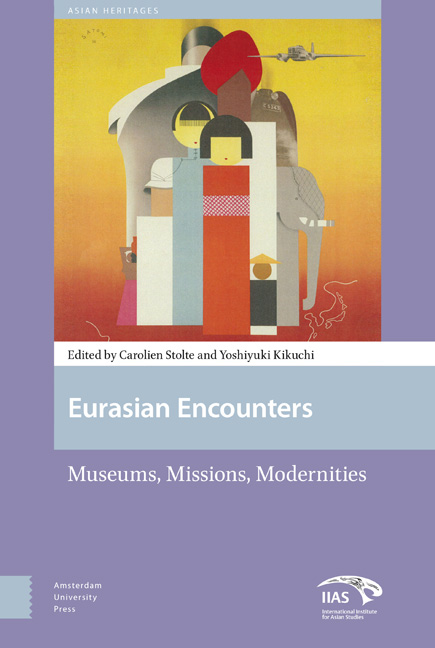Book contents
- Frontmatter
- Contents
- 1 Eurasian Encounters: Cross-border Intellectual and Cultural Exchange, 1900-1950
- Part I Artistic Spaces
- 2 The Museum at Aundh: Reflecting on Citizenship and the Art Museum in the Colony
- 3 Exhibiting the Nation: Cultural Flows, Transnational Exchanges, and the Development of Museums in Japan and China, 1900-1950
- 4 Parallel Tracks: Pan Yuliang and Amrita Sher-Gil in Paris
- 5 Bauhaus and Tea Ceremony: A Study of Mutual Impact in Design Education between Germany and Japan in the Interwar Period
- Part II Missions and Education
- 6 Schooling a Missionary in Early Twentieth-Century Eastern India
- 7 The Catholic Church in China in the First Half of the Twentieth Century: The Establishment of Zhendan University and Furen University
- Part III Shared Trajectories, New Subjectivities
- 8 Indigenizing Cosmopolitanism: Shifting Metropolitan Subjectivities in Twentieth-century Colombo
- 9 Fighting for the Soviet Empire: War Propaganda Production and Localized Discourses on Soviet Patriotism in Uzbekistan during the Second World War
- 10 Shared Origins, Shared Outcomes?: Transcultural Trajectories of Germany and Japan during the Asia-Pacific War
- Index
2 - The Museum at Aundh: Reflecting on Citizenship and the Art Museum in the Colony
Published online by Cambridge University Press: 12 December 2020
- Frontmatter
- Contents
- 1 Eurasian Encounters: Cross-border Intellectual and Cultural Exchange, 1900-1950
- Part I Artistic Spaces
- 2 The Museum at Aundh: Reflecting on Citizenship and the Art Museum in the Colony
- 3 Exhibiting the Nation: Cultural Flows, Transnational Exchanges, and the Development of Museums in Japan and China, 1900-1950
- 4 Parallel Tracks: Pan Yuliang and Amrita Sher-Gil in Paris
- 5 Bauhaus and Tea Ceremony: A Study of Mutual Impact in Design Education between Germany and Japan in the Interwar Period
- Part II Missions and Education
- 6 Schooling a Missionary in Early Twentieth-Century Eastern India
- 7 The Catholic Church in China in the First Half of the Twentieth Century: The Establishment of Zhendan University and Furen University
- Part III Shared Trajectories, New Subjectivities
- 8 Indigenizing Cosmopolitanism: Shifting Metropolitan Subjectivities in Twentieth-century Colombo
- 9 Fighting for the Soviet Empire: War Propaganda Production and Localized Discourses on Soviet Patriotism in Uzbekistan during the Second World War
- 10 Shared Origins, Shared Outcomes?: Transcultural Trajectories of Germany and Japan during the Asia-Pacific War
- Index
Summary
Abstract
The birth of the museum in India takes place in the context of colonial modernity in the early nineteenth century. A significant body of scholarship has developed around the dynamics between colonialism and the museum. However, both art museums and museums established by Indians have received far less attention. The paper focuses on the Shri Bhavani art museum in the princely state of Aundh in colonial India, established by its last ruler, Balasaheb Pant Pratinidhi in 1938. In that same year, Balasaheb made the declaration of ‘giving away’ his ruling powers to his subjects, a socio-political movement retrospectively called the ‘Aundh Experiment’. Aundh's art museum and Balasaheb's declaration are both emblematic of the rising tide of Indian nationalism during the Second World War. Through its establishment as well as through the nature of its collections, the museum was more than a simple reflection of this nationalism. Rather, as this chapter demonstrates, the Museum was actively engaged in the task of producing citizens out of subjects for the Indian nation to come.
This chapter focuses on the establishment of an art museum, the Shri Bhavani Chitrasangrahalaya (art museum) in the former princely state of Aundh, in present-day Maharashtra, India. The museum was founded in 1938 by its last royal ruler, Bhawanrao Pant Pratinidhi alias Balasaheb (1868-1951, ruled 1909-1948), ten years before Aundh merged with the newly independent Indian state. In the same year, Balasaheb initiated what is now known as the ‘Aundh Experiment’, in which he ‘handed over’ his ruling powers to his subjects. Balasaheb was not the first or only ruler to establish a museum in his principality, but Aundh's museum is interesting as one of the earlier Indian museums that self-identifies specifically as an art museum. At the time, the dominant model of the museum in the colony was the encyclopaedic or general-survey type of museum.
The art museum, when it emerged in the European context, has been understood as ‘inculcating bourgeois civic values that served the needs of the emerging nation state and the dominant interests within it’. In the Indian subcontinent, the institution of the museum was a European export making its way into India under the impress of colonial modernity in the early nineteenth century.
- Type
- Chapter
- Information
- Eurasian EncountersMuseums, Missions, Modernities, pp. 25 - 46Publisher: Amsterdam University PressPrint publication year: 2017

